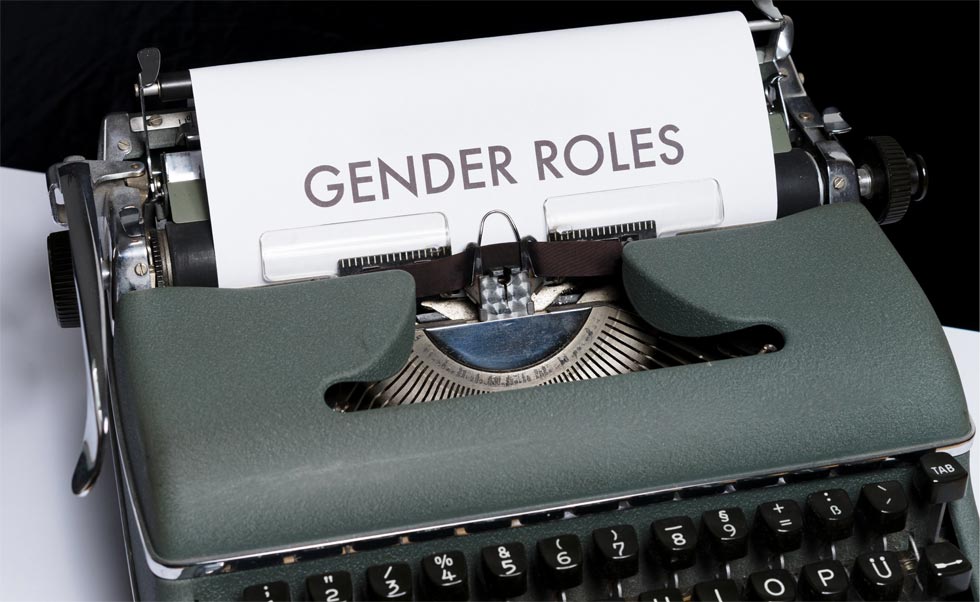Recently CBSE grade 10th English Board paper had a passage that caused much furore and was eventually dropped. This outrageously misogynistic passage contained the following lines – ‘…wives stopped obeying their husbands and that is the main reason children and servants are undisciplined’ and ‘women gaining independence is the main reason for a wide variety of social and family problems’. The presumptive gender roles according to this passage were – women have to obey men who take decisions and a change in this equation causes familial disruption. These innately patriarchal stereotypes are imbued in us through structural socialization – both consciously and unconsciously. Ironically, these practices are observed in households not only in India, but across the world. It has roots in various structures of the society – family, schools, work, media, etc. Aren’t the following phrases – ‘Men don’t cry’, ‘Why are you crying like a girl?’ and ‘Come on be a man’ – very commonly used around us. But do we really pause and ponder that they actually stem from typical gender stereotypes that the society weaves?
Gender Stereotypes in India
India is unique and at times unpredictable, on one hand women are put on a pedestal and worshiped as Goddesses while on the other they are subjected to brutal instances of crime. Girls are told that the father’s house is alien and her ‘husband’s family’ is her real abode, where she really belongs. Whereas boys are told that they need to care for their aging parents, build a house and earn money to marry a ‘beautiful wife’. In family gatherings, the females ought to serve food, while men chat over economy and politics. Wife beating is acceptable in many households but a woman who stands up to an abusive husband is a home breaker. A man willing to cook for his family is considered ‘henpecked’ and those who look after their children are being ‘on dictated terms by their wives’. The interpersonal relationships in the family unit inculcate gender roles to begin with – men as earning members, women as caregivers – men dominating and taking important decisions, women submissive and implanting decisions taken by the men of their houses. Many times, especially on Indian roads – bad driving and a woman driver are used interchangeably. However, this misplaced stereotype associated with women as poor drivers was shattered by a Delhi traffic police authority report, which claimed that women drivers cause less than 2% of fatal road accidents.
Genesis Of Gender Socialization


Breaking the Stereotypes. Credits: Through the Woods
Gender socialization begins at birth, intensifies during adolescence and continues for the rest of our lives. It contributes to gender inequalities in education, employment, income, empowerment, and other significant outcomes of well-being. The most recent trend which cements gender differentiation throughout the world is that color blue is for boys and color pink is for girls, toy cars are for boys while girls are supposed to play with dolls. Parents, schools as well as the toy industry contribute to ‘toy differentiation’ and provide ‘gender specific’ toys to children. Adults have assigned gender to toys, jokes are cracked about boys if they are found with dolls, or if girls are found playing with remote-control cars.
Breaking the Stereotypes. Credits: Through the Woods
In the 19th century, there were no color-coded gender labels; in fact boys at the time would wear pink while girls were seen wearing blue. Until the age of 7, both boys and girls would wear (mostly white) dresses. It is said that children acquire their prospective gender roles through socialization, which is a process in which people act in a way that is dictated by our societal values, norms, expectations, beliefs, and attitudes. Overgeneralizing of traits, behavioral patterns, and attitudes is how I loosely see stereotyping as. For example, women are not considered strong or brave enough to ride a bike which is a domain reserved exclusively for men. Men are discouraged and laughed at if they show interest in fashion while women are actively encouraged and appreciated for harboring such interests. Look no further, eyebrows are raised when men engage in fashion. Some popular examples are from India’s queer influencers, drag icons like Sushant Divgikar, to male beauty influencers, and mainstream bollywood actors – all breaking the stigma. This does not just end at fashion; it only begins from there. Our society actively differentiates in the workspace on the basis of gender. In India for instance drivers of public transport, politicians, and armed forces are predominantly male oriented while desk jobs are reserved for women.
The term ‘sex’ and ‘gender’ are often used interchangeably, however, it is important to distinguish between the two. Gender is an individual’s social identity that results from their culture’s conceptions of masculinity and femininity – and their respectively defined roles. Though ‘gender’ is not directly linked with one’s biological sex, it is a social construction that comes with real life consequences. While ‘sex’ is biologically and physiologically determined based on an individual’s anatomy at birth. But now people are both vocal and expressive about their identities – beyond just the male and female version – pansexual, gender queer, trans gender, lesbian, gay, bisexual, aromantic, asexual, two-spirit, heterosexual, homosexual, and so on are seen in the society.
Society has created a norm that only revolves around aggression, strength, and dominance for men while nurturing, subordination, and passivity for women. But there clearly exists something in between ‘born that way’ and ‘my choice’. Experts acknowledge the fact that, with the limited knowledge and terminology that humans possess, they are unaware of the many natural variations present around them. Gluing the stereotypes of how timid and feminine a woman should behave or how men are not supposed to be emotional and are only supposed to be strong, cements these traditional norms of masculinity and femininity.


Gender Stereotypes are promoted by parents and teachers. Credits: India Today
Socialization of gender generally develops through four components of socialization, which are family, school, peers, and mass media. Parents socialize their kids, both sons and daughters, differently in the traditional society which usually results in greater privileges for sons. For instance, boys do not have a curfew which requires them to return home before a specific time, while there is no girl without a curfew. Families supply ‘gender appropriate’ chores to the two, daughters are expected to help with domestic chores and household duties while boys are supposed to relax. Children are given ‘gender differentiated’ toys, like superhero paraphernalia, toy guns, motor cars and trucks for boys and dolls & dress up apparel for girls. Boys are associated with strength and toughness while girls are associated with neatness and care. Girls are supposed to ‘Be Ladylike’ and boys are not supposed to be henpecked. In schools, there has always been a segregation in which boys are encouraged for a science & mathematics course while girls are encouraged with humanities and arts courses. Teachers unknowingly produce gender differentiation in much obvious ways. For instance, praising boys much more than girls which comes out as a sense of comparison rather than collaboration, or the liberty given to boys to break free of rules to commit acts of deviance while girls are expected to stay in limits and follow rules carefully and obediently.


Assertive women are termed aggressive while a man with the same trait is strong; on the contrary, a sensitive man is considered sissy and is accused of ‘acting like a girl’. Mass media, being a significant agent for socialization, reaches audiences from all the strata of society and the gender stereotypes are more evident here than anywhere else. Advertising agencies have adopted gender stereotypes with one stark example of Seagram’s Imperial Blue ‘Men Will Be Men’ campaign. This advertisement, over several years, has represented an intrusive sexist male gaze which has helped in the marketing of alcoholic beverages. Besides the marketing success, such celebratory repeated statements enable normalization of an objectionable mode of personal conduct. The statement ‘Men Will Be Men’ is often used to justify objectionable and sexist male behavior, and women tend to be at the receiving end of such behavior. Television commercials to blockbuster movies the roles are developed and portrayed steeped in gender socialization. Male and female actors are over and under presented respectively in roles that involve traits like leadership, intelligence or balanced psyche. Male actors are given significant roles with more screen time, dialogues while female actors are portrayed as one of the two extremes, either as a wholesome like figure or a malevolent hypersexual figure. Men naturally portray superheroes and protectors while females play roles of being a wife or a mother.
Gender Stereotypes Affect Mental Wellbeing
All the gender stereotyping has an impact on mental wellbeing. In India, the households give certain types of privileges to their male counterparts. According to a Nielsen survey of 6500 women across the world, it was found that Indian women are the most stressed in the world today; 87 percent of Indian women felt stressed all the time. In a patriarchal society like ours, there are no restricted avenues for women which ultimately smothers their freedom and capabilities. There is the added stress that body shaming brings, which is again gender based. This makes any girl more vulnerable, fills her with doubt and impacts her self-esteem. This is not just an issue for the girl child, but the male child also faces self-esteem issues due to a different kind of pressure that emanates from gender roles determined by society. The male child is pressured with the fact that they need to fill in their father’s shoes by being breadwinners, taking care of the family business, irrespective of their interest.
Gender socialization is a lifelong process. Irrespective of the sex we are born with, the beliefs about gender that we acquire in childhood affects us throughout our lives. The impact of this socialization can be big (shaping what we believe we are capable of accomplishing and thus potentially determining our life’s course), small (influencing the color we choose for our clothes), and/or somewhere in the middle (choosing the careers we opt for). As adults, our beliefs about gender may grow more distinguished or flexible, but gender socialization can still affect our behavior, whether in school, the workplace, or our relationships. Hence, it is imperative that we, as society, differentiate carefully between the two, for our future generations to break these traditional perceptions. And for that to happen, the media, teachers, co-workers, peers and most importantly families will have to assist us in this journey.
References
Jain, S. (2020). Gender socialization and gender stereotypes. IPleaders Blog.
Retrieved from https://blog.ipleaders.in/gender-socialization-gender-stereotypes/
Learning, Lumen. (2021). Reviewing Theories on Deviance. Introduction to Sociology
Economic Survey of India (2019). Government of India


Kaushiki Singh Shrinet is a first year student at O. P. Jindal University pursuing BA (Hons.) Liberal Arts and Humanities. Currently, she is interning with CSR’s Media and Communications Department. She believes in smashing the patriarchy one step at a time. She is also an enthusiastic reader, writer, and photographer.





